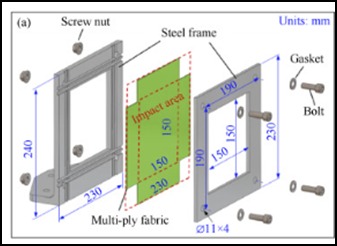Este documento informa sobre los resultados de evaluaciones experimentales y numéricas sobre los mecanismos que permiten mejorar el rendimiento balístico de los sistemas de tejidos espaciados de múltiples capas. Las pruebas de penetración fueron realizadas en un rango de velocidades de impacto que van desde 200 a 400 m/s. Los resultados confirmaron que la separación entre capas es beneficiosa para la capacidad de absorción de energía de los sistemas. Esto es porque las capas delanteras tienden a absorber más energía cuando no están inmediatamente limitadas por las capas traseras. También se encontró que el desempeño balístico de los sistemas espaciados está influenciado por el espesor de la capa, la velocidad del impacto y el orden de apilamiento de los espacios entre capas.
Abstract
It has been reported that the ply gap influences the ballistic resistance of spaced multi-ply fabric systems, but its working mechanism was not well-understood. This paper reports the experimental and numerical approaches and results of an investigation on the mechanisms that enable the improved ballistic performance of spaced multi-ply systems. Penetration tests were performed over a range of impact velocities ranging from 200 to 400 m/s. The results confirmed that the ply gap is beneficial to the energy absorption capability of the systems. This is because the front plies tend to absorb more energy when they are not immediately constrained by the rear plies. During a ballistic event, the gap relieves the reflection of the compressive pulse, prolonging the projectile engagement time with the front plies; on the other hand, the rear plies become increasingly less active in dissipating energy as the gap increases. When the gap is sufficiently widened to avoid any interference between the plies before the failure of the front ply, the responses of the whole system no longer vary. It was also found that the ballistic performance of the spaced systems is influenced by ply thickness, impact velocity, and the stacking order of the ply gap.
![]() Fuente: https://www.sciencedirect.com
Fuente: https://www.sciencedirect.com


